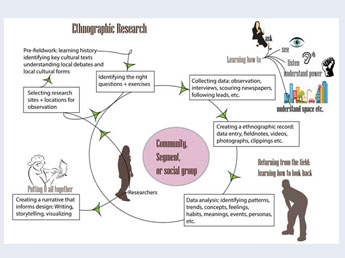
Frameworks for interpretation
Unfortunately, there are no cookie-cutter formulae that allow us to simply and systematically amass information about people and culture, nor any real substitute for thorough, well-designed in-place field research. But here are some key techniques, borrowed and adapted from ethnography as anthropologists conduct it, by which to guide inquiry toward specific cultural forms and processes that are the all-important clues to effective design:
- Understand social organization
Long an anthropological preoccupation, familiarization with the structure and organization of communities at the familial, societal, and national levels can be key to understanding social hierarchy and diversity, and therefore norms, allegiances, and relationships. Structure offers a snapshot of a culture’s own regulatory frameworks. In what sort of race/class/ethnic social groupings are communities organized? Who belongs in which group, and who doesn’t? What impact do these realities have on access to services and resources? Countries with greater non-governmental organization activity would be contexts in which communities are more disconnected from state resources, potentially searching for alternative routes to address basic needs.
Social form also provides clues to understanding emotion and affect, crucial to building emotive appeal. Key concepts‚ÄĒfor instance, saudade in Brazil (literally, the love that remains; nostalgia, longing), the multiple words used to describe “shame” in Arabic, or amae (dependence, respect, and obligation) in Japan‚ÄĒprovide intimate insight into the organization of social life, and tell us a great deal about permissible emotional expression, the distinctions of public and private, individual and collective responsibility, authority, and so on. These ideas, in turn, point out what is meaningful in a culture and how, or what must be negotiated for effective design innovation.
- Understand exchange
Also a classic anthropological focus, exchange tells us about the values people assign to goods, relationships, and resources.
By following objects as they are exchanged for money, gifts, in sharing arrangements and more, we track human networks. We learn also about how equivalencies are created ‚ÄĒ advice on college admissions exchanged for money here, for flowers there, expected to be free elsewhere ‚ÄĒ and the relationships that create such modulations. Gifts are often carefully computed metrics by which social relationships are maintained, challenged, or enhanced at key moments in a life or during the year. The terms “fong kong” and “zhing zhong,” used in southern Africa to refer to cheap, low quality, or counterfeit goods manufactured in China, are important clues to understanding the value (or lack thereof) attached to certain cultural forms. Copycat products lacking originality, aesthetic appeal, and technical capability suffer the “fong kong curse” precisely because they do not deliver the social progress and prestige that local communities are seeking. To boot, they replace local manufacturing!
- Understand aspirations in the here and now
Here we focus on obtaining a cultural snapshot of the present moment, to complement more overarching insights about tendencies. What are the most burning issues that recur on newspaper headlines, or in public conversation? What are the local debates, what images and stories are in circulation? These tell us about existing discontents, changes to old structures and institutions, the articulations of new ideologies and aspirations. For example, many younger Nigerians refer to their country as “Naija”; such new terminologies tell us about changing identity, national dissent, and youth expression.
Advertisements can also provide interesting (albeit untested) indices of current shifts. For instance: the Indian electrical equipment company Havells’ recent series of TV advertisements for ceiling fans show young Indians turning tables on a series of conventional decisions (naming a child by religion, taking a husband’s name on marriage, not eating meals with household help) with the tag-line: “Hawa badlegi” [the winds will change].
- Above all: Understand Native Points of View
The importance of understanding cultures from native points of view is at the core of all the points thus far presented, but it bears highlighting. For example: How do people experience the internet? Never the same way in two places, for information flow is regulated by telecom providers, governments, infrastructural realities, and human needs and habits in different ways. How do people cope with border crossings, migration, and diaspora? Some will fight for cultural rights in new homelands ‚ÄĒ whereas others are willing to make unthinkable compromises: “pure vegetarian” Indian chefs cooking meat dishes to cater to client palettes, or teetotalers opening alcohol shops. How do different groups within a country debate democracy or women’s rights? There are usually many more than two opposing factions, whether in the United States or in the wide swath that is the Arab world. Being sensitive to these local textures breaks apart any lingering sense of culture as a homogenous monolith, and introduces the specific variations in perspective that could provide crucial design hooks.
Each of these broad techniques will of course need to be broken down depending on the project at hand, but they act as keys to illuminate cultural practices. In-place field research would be the next logical step ‚ÄĒ but if that step cannot be taken or has to be limited, then the idea is to create an informed approach to meaningfully guide the design process.




